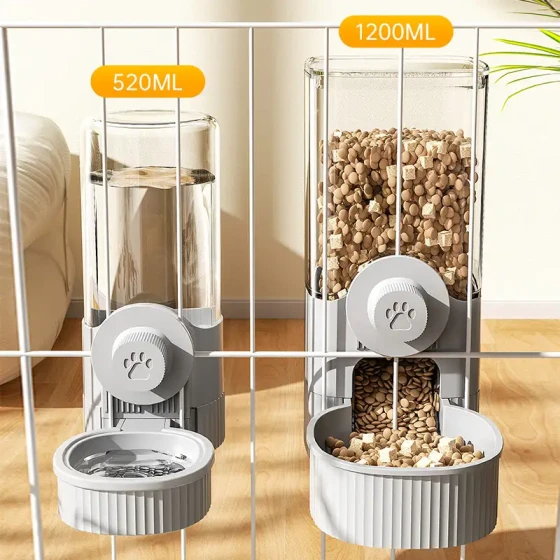Cat Pregnancy_Pregnant Cat Care Guide
Cat pregnancy is a sweet surprise for many cat owners, but it often comes with a hint of uncertainty and anxiety. After all, it’s not just about having more cute little ones at home, but also taking on the responsibility of nurturing a new life cycle. This wonderful journey, lasting about nine weeks (around 63 days), has its own rhythm. As companions, what we can do is understand, respect, and provide the strongest support.

First, how to tell if your cat is "expecting"? It’s not just about gaining weight. Early symptoms might be subtle, like slight behavioral changes—becoming unusually clingy, or abnormally preferring solitude. But the clearest signals usually appear around three weeks into pregnancy:
- Nipple changes (Pinking): This is one of the classic early signs. The cat's nipples become pinker and more prominent, especially during the first pregnancy. This is figuratively called “pinking up.”
- Abdominal swelling: As pregnancy progresses, the cat's abdomen will gradually enlarge, especially in the late stages. However, it’s important to distinguish pregnancy from simple weight gain or more serious issues like ascites.
- Appetite changes: Many pregnant cats may experience reduced appetite or mild vomiting early on, somewhat like human morning sickness. But in mid to late pregnancy, their appetite significantly increases, turning into a "gluttonous cat plus version."
- Behavioral changes: Besides the previously mentioned clinginess or solitude, some cats become quieter to conserve energy; others start seeking hidden, safe spots, which is the emergence of nesting instincts.
- Estrous cycle stops: If your female cat had regular heat cycles before, they naturally stop after becoming pregnant.
Of course, the above are observations and hypotheses. The most reliable way to confirm is to consult a professional veterinarian. Vets can diagnose by palpation (around 20 days into pregnancy, experienced vets can feel embryos), ultrasound (after 20 days, fetal heartbeats can be seen and litter size confirmed), or X-ray (after 45 days, fetal bones are visible for more accurate count but is not recommended during pregnancy unless necessary). Don’t try to feel yourself as a non-professional, which may harm the fetuses.
Pregnancy care: a gradual and scientific journey
Once the pregnancy is confirmed, a series of targeted adjustments are necessary. It's not just about large-scale supplementation but accurately meeting the growing needs of the cat and her fetuses.
1. Diet upgrade: provide sufficient and balanced fuel
This is the core of pregnancy care. Early pregnancy may not significantly change the cat’s food intake; existing high-quality cat food is adequate. But from mid-pregnancy (around week 4) onward, as the fetuses develop rapidly, the mother’s nutritional demands increase exponentially.
- Switch to high-quality kitten food: Why kitten food? Because kitten food usually contains higher levels of protein, fat, calcium-phosphorus ratio, and energy density, plus important nutrients like DHA that support brain development. These components perfectly suit pregnant and lactating cats. Choose reputable brands with reliable ingredients, avoiding poor-quality food.
- Small frequent meals: As the uterus enlarges occupying abdominal space, the cat might not eat large meals at once. Dividing daily rations into more meals (e.g., 3-5 times a day) helps digestion and maintains consistent energy supply.
- Always provide clean water: Metabolism speeds up during pregnancy, increasing water needs. Ensure the water dispenser is clean and water is fresh.
- Supplements? Be very cautious! Unless explicitly advised by a vet, do not casually give your pregnant cat vitamins, calcium, or other minerals. Especially calcium, as excessive or improper supplementation may disrupt normal calcium metabolism, increasing the risk of hypocalcemia (puerperal tetany) during labor, which is very dangerous. Balanced, high-quality kitten food usually covers all essential nutrients.
- Avoid raw meat and unpasteurized dairy: These may contain parasites or bacteria posing risks to the mother and fetuses.
Remember, increasing food amount is a gradual process; avoid abrupt drastic changes to prevent digestive troubles. Monitoring weight and mental state are important indicators of proper feeding.
2. Environment: create a quiet and safe refuge
Cats are natural hunters but need a strong sense of security. For pregnant cats, a stable, quiet, and stress-free environment is essential.
- Reduce stress: Avoid taking the pregnant cat outside or exposing her to strangers or other animals. Keep the home environment calm, avoiding loud noises or upheaval.
- Provide multiple resting and hiding spots: Pregnant cats look for places where they feel safe. Prepare comfortable mats or cat beds at different heights and corners around the home.
- Prepare a “birthing box” in advance: In the last two weeks of pregnancy, the cat’s nesting instinct strengthens. Prepare a birthing box placed in a quiet, warm, concealed, and easily accessible area (like a closet corner or storage room).
- Selection: It can be a cardboard box, plastic storage box, or a special birthing crate, large enough for the mother cat to stretch comfortably, with edges not too high, so she can easily enter and exit and kittens can crawl out later.
- Setup: Line the bottom of the box with soft, absorbent, easy-to-clean materials like old towels, clean rags, disposable nursing pads. Prepare multiple sets for change.
- Location: Away from high traffic areas, avoiding disturbance by other pets or children. Keep warm (around 22-25°C), but not overheated. You can place a heating pad (on low setting) under part of the box, but don’t cover the entire bottom, letting the cat choose a cooler spot if desired.
- Respect her choices: Sometimes cats pick unexpected places for birthing (like your closet or under the bed). If it's relatively safe and concealed, respect her choice. Place your prepared box near her selected spot and see if she moves. Do not forcibly confine her to the box.
3. Medical care: your veterinarian is your ally
Pregnancy doesn’t mean complete avoidance of medical care but requires extra caution.
- Regular prenatal checkups: Follow your vet’s recommendations to monitor the mother’s health and fetal development.
- Vaccinations and deworming: Important note: Routine vaccinations are usually not recommended during pregnancy, unless facing high infectious risk and the vet evaluates benefits outweigh risks. Deworming should also be done under vet guidance, as many dewormers affect fetuses. If needed, the vet will select safe drugs and dosages during pregnancy.
- Illness treatment: If the pregnant cat falls ill, immediately consult your vet and clearly indicate pregnancy. Many common medications are contraindicated during pregnancy.
- Watch for abnormalities: Notice any unusual discharge, sudden appetite loss, lethargy, abnormal temperature, and contact your vet promptly.
4. Labor preparation: waiting for the moment of fruition
During the last week of pregnancy, you’ll sense a mixture of tension and anticipation in the air. The mother’s abdomen droops more evidently, and mammary glands develop further. Behaviorally, she may spend more time in the chosen or prepared "birthing box."
Signs before labor:
- Temperature drop: 12-24 hours before labor, the mother’s rectal temperature may drop about 1°C (usually below 37.8°C). This is a fairly reliable sign.
- Restlessness or unusual calm: Some cats pace, meow, pant; others become abnormally quiet and hide.
- Loss or cessation of appetite: Many mothers stop eating in the 24 hours before labor.
- Excessive licking: Especially around the perineal area and abdomen.
- Contractions: Near labor, you can visibly see abdominal contractions.
As a companion, you need to prepare the following:
- Gather supplies: Clean towels (many), tissues, disposable gloves, vet’s phone number, emergency backup kitten food (high-energy for lactation). If necessary, prepare sterile scissors (for umbilical cord, though the mother usually bites it off herself, so avoid unless necessary) and povidone-iodine (for umbilical disinfection, also not usually necessary).
- Stay calm and observe: Most labors are smooth and natural; the mother’s instincts are strong. Your role is observer and logistic support. Stay nearby but avoid over-disturbing or crowding to prevent stress.
- Know when to intervene (and when not to): Non-interference is the rule, except in abnormal cases, for example:
- Strong contractions lasting 30-60 minutes but no kitten born.
- Visible limb or tail stuck in the birth canal, and mother unable to deliver.
- More than 2-3 hours since the last kitten, but you know there are still fetuses inside.
- Mother is extremely weak, excessive abnormal bleeding, or exhibiting severe pain.
- Mother shows lack of licking and care instinct toward newborn kittens.
In these situations, contact your vet immediately. They will guide you how to proceed or advise urgent hospital care if needed.
Postpartum first experience: new challenges and warm moments
After the kittens are born, the mother instinctively licks them clean, bites off the umbilical cords, and eats the placenta (providing energy and nutrients). Ensure all kittens are cleaned by the mother and begin to seek the nipples to nurse. The mother needs continued feeding of high-quality kitten food and abundant water to support milk production.
This is a phase full of love and responsibility. You need to continue providing a quiet, safe environment and monitor the health of both mother and kittens. But that’s a topic for another time.
Conclusion
Cat pregnancy and birth are among the most natural and mysterious processes of life. It doesn't require us to play God controlling everything but calls us to be responsible guardians, providing support, eliminating risks, and lending help when necessary. Every detail affects the safety of mother and offspring and is worth our time and patience to learn and practice. When you see those tiny new lives nestled beside the mother cat, softly meowing, the spontaneous emotion and sense of accomplishment will make all previous efforts worthwhile. This isn’t just pet ownership; it’s witnessing and safeguarding the continuation of life.

-560x560.webp)

-560x560.webp)